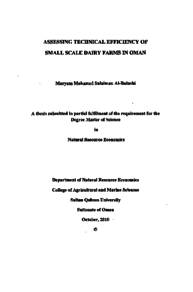Document
Assessing technical efficiency of small scale dairy farms in Oman.
Publisher
Sultan Qaboos University
Gregorian
2010
Language
English
Subject
English abstract
Currently the Oman economy depends on oil. Oil being a non-renewable resource, the neco eso government understands that oil deposits will be depleted someday. As a result, the government has put together vision 2020 strategies to diversify the economy away from oil to other non-oil sectors of the economy. Agriculture is one of the non-oil sectors. Under the 2020 vision agriculture is expected to grow by 4.1% annually so as to contribute 3.1% to the GDP of Oman by 2020. However, based on the recent past five year development plans, the performance of the agricultural sector has not been according to expectations. Among the challenges identified as being behind the poor performance of the sector include, low productivity of meat and milk from the local cow breeds. Assessing the efficiency of small scale dairy farms is therefore a first step towards finding solutions to the poor performance of the agricultural sector.
This thesis therefore seeks to assess the efficiency of small scale dairy farms in Oman.
Furthermore, the robustness of three popular functional forms namely, Cobb-Douglas
(hereafter, CD), Translogarithmic (hereafter, TL) and Generalized Leontief (hereafter,
GL) will be tested. Finally, regional efficiency differences (between the two main dairy producing regions of Salalah and Sohar) will be investigated.
Result shows that the TL functional form is robust than CD and GL. Dairy farms in
Oman are on average about 85% efficient, Regional wise, Salalah and Sohar dairy farms are respectively 81% and 77% technically efficient. These results imply that with better dairy husbandry practices, it is possible to increase milk production by 19% and 23% respectively in Salalah and Sohar with the same levels of inputs currently employed.
Member of
Resource URL
Arabic abstract
الاقتصاد العماني يعتمد حاليا على النفط. وهو مورد غير متجدد، والحكومة على دراية بأن احتياطيات النفط سيتم استنزافها يوما ما. ونتيجة لذلك ، وضعت الحكومة "الرؤية المستقبلية للاقتصاد العماني مسعمان۲۰۲۰" لتنويع الاقتصاد بعيدا عن النفط، واستغلال القطاعات غير النفطية الأخرى من الاقتصاد. وتعد الزراعة واحدة من هذه القطاعات غير النفطية، التي من المتوقع في إطار رؤية ۲۰۲۰ نموها بنسبة 4 . 1% سنويا وذلك لتساهم بنسبة ۳٫ 1 ٪ في الناتج المحلي القومي الإجمالي لعمان بحلول عام ۲۰۲۰. ولكن اعتمادا على الخطط الخمسية الماضية، وأداء القطاع الزراعي لم يكن الإنتاج وفقا للتوقعات. من بين التحديات التي كانت وراء ضعف أداء القطاع الزراعي انخفاض الإنتاجية من اللحوم والحليب من سلالات الأبقار المحلية، فإن الخطوة الأولى نحو إيجاد حلول لضعف أداء القطاع ه و تقييم الكفاءة التقنية لمزارع الألبان الصغيرة. هذه الأطروحة تسعى لتقييم كفاءة مزارع الألبان الصغيرة في السلطنة، وقياس مدى دقة المعادلات الأكثر شهرة، ألا وهي (كوب دوغلاس، وتراتلوجريثميك، وجنرلايز ليونتيف) التي سيتم اختبارها. واخيرا ، قياس كفاءة الاختلافات الإقليمية (بين أكثر المناطق إنتاجا للألبان صلالة وصحار) ليتم التحقيق فيها. والنتائج توضح أن المعادلة ترانلوجريثميك الأكثر دقة بين المعادلات الثلاث السابقة. وأظهرت الأطروحة أن متوسط كفاءة مزارع الألبان الصغيرة في سلطنة عمان يبلغ نحو 85 %. تبلغ الكفاءة التقنية لمزارع الألبان في صلالة وصحار على التوالي ۸۱ ٪ و ۷۷ ٪. هذه النتائج تعني أنه من الممكن زيادة إنتاج الحليب بنسبة ۱۹ ٪ و ۲۳ ٪ على التوالي في صلالة وصحار مع نفس مستويات المدخلات المستخدمة حاليا۔
Category
Theses and Dissertations

